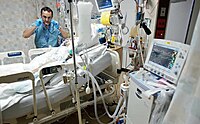
Photo from wikipedia
BACKGROUND Paediatric cardiac critical care continues to become more sub-specialised, and many institutions have transitioned to dedicated cardiac ICUs. Literature regarding the effects of these changes on paediatric critical care… Click to show full abstract
BACKGROUND Paediatric cardiac critical care continues to become more sub-specialised, and many institutions have transitioned to dedicated cardiac ICUs. Literature regarding the effects of these changes on paediatric critical care medicine fellowship training is limited. OBJECTIVE To describe the current landscape of cardiac critical care education during paediatric critical care medicine fellowship in the United States and demonstrate its variability. METHODS A review of publicly available information in 2021 was completed. A supplemental REDCap survey focusing on cardiac ICU experiences during paediatric critical care medicine fellowships was e-mailed to all United States Accreditation Council of Graduate Medical Education-accredited paediatric critical care medicine fellowship programme coordinators/directors. Results are reported using inferential statistics. RESULTS Data from 71 paediatric critical care medicine fellowship programme websites and 41 leadership responses were included. Median fellow complement was 8 (interquartile range: 6, 12). The majority (76%, 31/41) of programmes had a designated cardiac ICU. Median percentage of paediatric critical care medicine attending physicians with cardiac training was 25% (interquartile range: 0%, 69%). Mandatory cardiac ICU time was 16 weeks (interquartile range: 13, 20) with variability in night coverage and number of other learners present. A minority of programmes (29%, 12/41) mandated other cardiac experiences. Median CHD surgical cases per year were 215 (interquartile range: 132, 338). When considering the number of annual cases per fellow, programmes with higher case volume were not always associated with the highest case number per fellow. CONCLUSIONS There is a continued trend toward dedicated cardiac ICUs in the United States, with significant variability in cardiac training during paediatric critical care medicine fellowship. As the trend toward dedicated cardiac ICUs continues and practices become more standardised, so should the education.
Journal Title: Cardiology in the young
Year Published: 2022
Link to full text (if available)
Share on Social Media: Sign Up to like & get
recommendations!